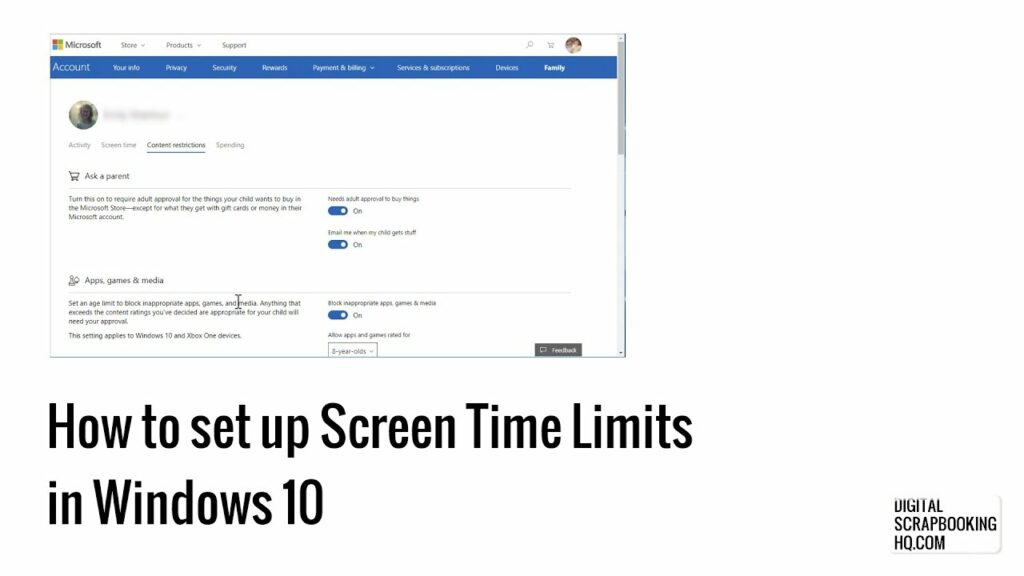Nurturing Digital Wellness: A Comprehensive Guide on How to Set Screen Time for Kids in Windows 10

Introduction:
In the age of digital proliferation, balancing technology usage for children is a crucial aspect of responsible parenting. Windows 10 recognizes this need and provides a robust set of parental control features, including the ability to set screen time limits for kids. This comprehensive guide will explore the intricacies of setting screen time for kids in Windows 10, empowering parents and guardians to foster healthy digital habits and ensure a balanced digital lifestyle for their children.
1. Understanding the Importance of Screen Time Limits: Digital Well-Being for Kids
Screen time limits play a pivotal role in safeguarding the well-being of children in the digital age. Striking a balance between technology usage and other activities is essential for healthy development, improved sleep patterns, and enhanced focus. Windows 10’s parental control features provide parents with the tools to establish reasonable screen time limits, promoting responsible and mindful technology use.
2. Creating a Child Account in Windows 10: The Foundation of Parental Controls
Before setting screen time limits, parents need to create a child account for their kids in Windows 10. To do this:
- Open the Settings menu (Win + I) and navigate to “Accounts” > “Family & other users.”
- Click on “Add a family member” and select “Add a child.”
- Follow the prompts to create a new Microsoft account for your child.
Once the child account is created, parents gain access to a suite of parental control features, including screen time management.
3. Configuring Screen Time Limits: Tailoring Digital Habits
Windows 10 allows parents to set daily screen time limits for their child’s device usage. To configure screen time limits:
- Open the Settings menu and go to “Accounts” > “Family & other users.”
- Under “Your family,” click on the child account for which you want to set limits.
- Click on “Screen time” in the left sidebar to access screen time settings.
- Set specific time limits for each day of the week, adjusting the hours according to your preferences.
These customizable screen time limits empower parents to tailor their child’s digital habits based on family routines and priorities.
4. Configuring App and Game Limits: Balancing Entertainment and Education
In addition to overall screen time limits, Windows 10 allows parents to set specific limits for individual apps and games. To configure app and game limits:
- Navigate to “Settings” > “Accounts” > “Family & other users.”
- Select the child account and click on “App and game limits.”
- Choose the specific app or game you want to limit and set the allowed time.
This feature ensures a balanced approach to screen time, allowing children to engage with educational apps while managing recreational gaming.
5. Enabling Web Filtering: Safe and Secure Browsing
Windows 10’s parental control features extend to web filtering, providing an additional layer of online safety for children. To enable web filtering:
- Open the Settings menu and go to “Accounts” > “Family & other users.”
- Select the child account and click on “Content restrictions.”
- Toggle on “Only allow websites on the allowed list” and add specific websites to the list.
Web filtering ensures that children have a safe and age-appropriate online experience while using their devices.
6. Activity Reporting: Insight into Digital Habits
Windows 10 offers parents a comprehensive overview of their child’s digital habits through activity reporting. To access activity reports:
- Navigate to “Settings” > “Accounts” > “Family & other users.”
- Select the child account and click on “Activity reporting.”
- Review the activity summary to gain insights into app usage, web browsing, and screen time.
Activity reporting allows parents to stay informed about their child’s digital activities, fostering open communication and trust.
7. Remote Management with Microsoft Family Safety App: Flexibility for Parents
For added flexibility and convenience, parents can utilize the Microsoft Family Safety app to manage screen time and parental controls remotely. The app allows parents to set limits, review activity reports, and manage family settings from their smartphones, providing a seamless and accessible approach to digital parenting.
Conclusion: Cultivating Responsible Digital Citizens
In conclusion, setting screen time for kids in Windows 10 is an integral component of cultivating responsible digital citizens. The comprehensive parental control features empower parents to strike a balance between technology use and other essential aspects of their child’s life. By creating child accounts, configuring screen time limits, managing app and game restrictions, enabling web filtering, and utilizing activity reporting, parents can ensure a healthy and balanced digital environment for their children. The tools provided by Windows 10 contribute to the development of responsible digital habits, encouraging a mindful and well-rounded approach to technology use in the dynamic landscape of the digital age.







